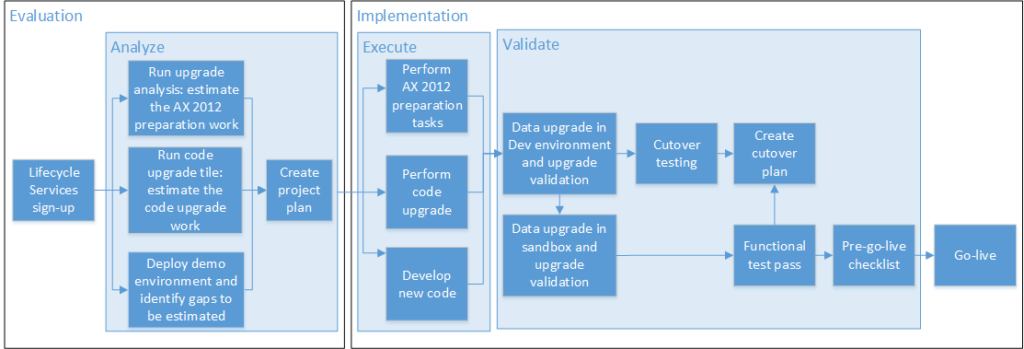Upgrade AX 2012 to Dynamics 365 Finance and Operations
Why you should upgrade AX 2012 to Dynamics 365 Finance & Operations
For you to be on top of your business, an up to date ERP solution is compulsory. If you are dealing with an outdated Dynamics AX ERP, now is the best time to switch! Upgrade from earlier versions of Dynamics AX to the all-new Dynamics 365 Finance & Operations with CloudFronts. The process of upgrade brings a lot of feature enhancements and other benefits to your business.

Rethink what is possible for your business and its expansion with Dynamics 365 that unifies CRM and ERP capabilities into applications that work seamlessly together across sales, customer service, field service, operations, financials, marketing, and project service automation. Start with what you need, add applications as your business grows. With Dynamics 365 for Financials & Operations, engage your customers, empower employees, optimize operations, reinvent products and business models.
Key Benefits of Data Upgrade from AX 2012 to D365
Functional Enhancements
Moving to Microsoft Dynamics 365 will provide New features and capabilities, including embedded BI and availability on mobile devices, that an organization can take advantage of.
A common data model
ERP and CRM under same platform – Upgrading from Dynamics AX to Dynamics 365 for Financials & Operations makes it easier to integrate your ERP, CRM, BI and IoT all in the Dynamics 365 range. Your operational and financial data shares a single common data source. This is a significant development, and the potential is enormous.
Reduced Maintenance & Stay Updated
Eliminates on premise servers and systems that require maintenance and upgrade. Microsoft takes responsibility for monitoring and updating the underlying platform and the application itself. Stay up to date with platform updates (every 3 months) and application updates (every 6 months), eliminating the need for any expensive and major version upgrades every few years.
Improved Accessibility
Microsoft Dynamics 365 utilizes a native HTML5 browser based user interface, which can run on any device, any platform, and any browser. This simplifies access to the application from any type of user device.
BI
Microsoft Dynamics 365 now includes a real-time, in-memory BI solution that provides up-to-the-minute information around how your business is performing, with new tools (Power BI) for visualizing this data and creating dashboards.
Why Dynamics 365 for Finance & Operations?
New end user interface
A new user experience, with new features and industry functionality across retail, manufacturing, finance, and supply chain management gets users up to speed quickly. And through the power of the cloud, users can unlock new capabilities to make implementations easier and improve productivity.
Platform Elasticity
By harnessing the power of the cloud, the new Microsoft Dynamics 365 provides elasticity for businesses to scale up or down so they can grow at their own pace. With Microsoft AppSource and Azure’s global footprint, businesses can scale globally quickly.
Predictable implementations
With Lifecycle Services (LCS) in the new Microsoft Dynamics 365, organisations get quicker, more predictable paths to achieving results. By getting enterprise best practices across every phase of the project lifecycle, LCS empowers organisations to deliver predictable, efficient, best practice implementations.
Reduce customisations
Customers can now take advantage of new standard functionality that could reduce customisations. Many common customisations are now available as new standard functionality. This decreases set up time and allows teams to spend less time coding and more time enjoying the benefits.
Reduce Hardware costs
By harnessing the power of the cloud, the new Microsoft Dynamics 365 provides elasticity for businesses to scale up or down so they can grow at their own pace. With Microsoft AppSource and Azure’s global footprint, businesses can scale globally quickly.
Mobile Ready
Microsoft Dynamics 365 is mobile-ready. Connected mobile solutions allow access to the same line-of-business applications employees rely upon in the office while they’re away. Users can access their Dynamics 365 accounts & Power BI reports on mobile devices, & leverage innovations such as mobile & cloud POS.
Out of the box HA/DA
The new release brings with it the benefits of the cloud that are most important for business — from simple signup, immediate provisioning, built-in high availability and disaster recovery, as well as elastic capacity to easily scale to meet the needs of your business.
Integration with productivity tools
The new Microsoft Dynamics 365 brings enhanced integration with productivity tools that users love, including Power BI and Office 365. Now users can streamline updates by working directly in Excel and dive into their data with custom dashboards built in Power BI.
Migration Tools
The new Microsoft Dynamics 365 makes it easier than ever to migrate code and data with new tools and services. This includes configuration and setup, balances, open documents and pending invoices, system configuration, and anything else that has an entity.
